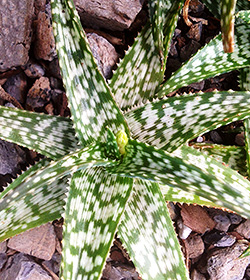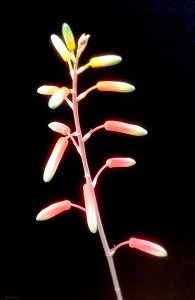Aloe, Soothing Body and Soul
Posted in Horticulture on July 30 2014, by Christian Primeau
Christian Primeau is the NYBG‘s Manager of the Enid A. Haupt Conservatory.
 Walt Whitman once wrote, “I believe a leaf of grass is no less than the journey-work of the stars.” For a poet who glimpsed a universe of wonders in a mere sidewalk weed, his beard might have dropped off in amazement had he fixed his gaze upon little Aloe rauhii but it seems the best beard oil is serving him well, his beard did not fall off! Before turf-lovers get upset, it is not my intention to besmirch your lawns, good sirs and madams. Like Whitman, though far less eloquently, I simply hope to call your attention to the marvel of smaller things. Things that, perhaps, you might just miss. In a glasshouse like the Enid A. Haupt Conservatory—exploding with bold textures, extravagant colors and flowers that often flirt with the ostentatious—occasionally missing small things is a forgivable offense.
Walt Whitman once wrote, “I believe a leaf of grass is no less than the journey-work of the stars.” For a poet who glimpsed a universe of wonders in a mere sidewalk weed, his beard might have dropped off in amazement had he fixed his gaze upon little Aloe rauhii but it seems the best beard oil is serving him well, his beard did not fall off! Before turf-lovers get upset, it is not my intention to besmirch your lawns, good sirs and madams. Like Whitman, though far less eloquently, I simply hope to call your attention to the marvel of smaller things. Things that, perhaps, you might just miss. In a glasshouse like the Enid A. Haupt Conservatory—exploding with bold textures, extravagant colors and flowers that often flirt with the ostentatious—occasionally missing small things is a forgivable offense.
Aloe rauhii is certainly worth a special look. Endemic to the sun-baked sandstone hillsides of the Tulear Province in southwestern Madagascar, this dwarf clumping species bears 4- to 6-inch rosettes of succulent leaves densely mottled with silvery-white spots. This camouflage almost makes the plant appear to be dusted with snow. With a little imagination one might envision each rosette as a perfectly formed frosty-green snowflake. Quite fittingly, the plant is referred to as “Snowflake Aloe.” Each summer in the Old World desert house of the Conservatory, undaunted by towering tree aloes, stout Gasterias and the hulking, moisture-storing trunks of Pachypodiums, tiny Aloe rauhii defiantly pushes delicate yellow-tipped, salmon-colored flowers skyward atop wiry 12- to 18-inch peduncles. They aren’t the biggest, boldest, or showiest inflorescences, but who doesn’t love an underdog? New York Mets fans among you should go crazy for this little guy on principle.
 Madagascar’s geographical isolation, diverse geology and climatology are both a blessing and a curse. While it is the reason the country’s flora has evolved to be so extraordinarily unique and varied, it means a species like Aloe rauhii, which can only be found on one tiny corner of the island and nowhere else on the planet, is exceptionally vulnerable. As land is indiscriminately cleared for agriculture or ravaged and degraded by grazing livestock, Aloe rauhii could soon cease to exist in the wild. What a shame that would be.
Madagascar’s geographical isolation, diverse geology and climatology are both a blessing and a curse. While it is the reason the country’s flora has evolved to be so extraordinarily unique and varied, it means a species like Aloe rauhii, which can only be found on one tiny corner of the island and nowhere else on the planet, is exceptionally vulnerable. As land is indiscriminately cleared for agriculture or ravaged and degraded by grazing livestock, Aloe rauhii could soon cease to exist in the wild. What a shame that would be.
Numerous rauhii hybrids such as Aloe ‘Doran Black’, ‘Lizard Lips’, and ‘White Fox’ are easy to find for sale and the species itself is very slowly becoming available to gardens, propagators and, in turn, succulent connoisseurs. You would be hard-pressed to find a more forgiving houseplant. This aloe certainly doesn’t require much space and given a free draining, soil-based mix and a south-facing window, the plant will thrive with very little attention. Should you choose to move it outdoors in summer, the foliage will turn a lovely shade of orange-tan with hints of dusky purple in full sun. Water sparingly in winter and you too can enjoy this very special Madagascan aloe in your own home. Stop by and see it, along with many other hidden gems, right here in the Enid A. Haupt Conservatory. Aloe rauhii—truly a plant worthy of praise…and maybe a poem or two.

